
ncert class 12 biology notes pdf download, class 12 biology notes chapter 5, class 12 biology handwritten notes pdf, ncert biology class 12 notes pdf , class 12 biology notes priyanka tyagi, class 12 biology notes study rankers, cbse class 12 biology chapter 2 notes, genetics, biotechnology, microbiology, bioinformatics, biochemistry, science, chemistry, hereditary diseases, zoology, chromosomal abnormalities, geneticist, guanine, inherited diseases, human chromosomes, , genetics and molecular biology impact factor 12 notes, class 12 biology notes, genetics and molecular biology impact factor class 12, genetics and molecular biology impact factor class 12 notes, class 12 genetics and molecular biology impact factor, note biology, biology notes, genetics and molecular
Relationship between genes and chromosome of diploid organism and the terms used to describe them
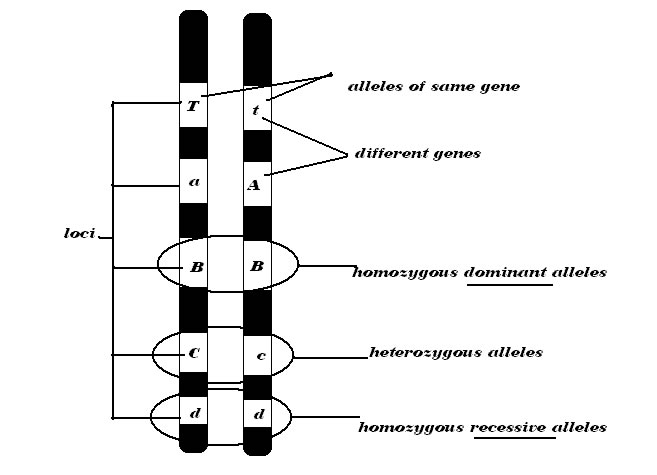
| Terms | Meaning | E ×ample |
| Locus | Address/ location of a gene in a chromosome | T,A.b,d etc |
| Allele | Allelomorphs= alternative form of a gene | T and t OR A and a etc |
| Homozygous | Both alleles of a gene at a locus similar | AA or aa |
| Heterozygous | Both alleles of a gene at a locus dissimilar | Aa or Tt etc |
| Homozygous Dominant | Both alleles of a gene at a locus similar & dominant | AA |
| Homozygous recessive | Both alleles of a gene at a locus similar & recessive | aa |
( Law of dominance )characters are controlled by discrete units called genes (allele) which occur in pair. In heterozygous condition only one gene that is dominant can e ×press itself. (Can be e ×plained by monohybrid cross)
(Law of segregation): The two alleles received, one from each parent,
segregate independently in gamete formation, so that each gamete receives one or the other with equal
probability. (Can be e ×plained by monohybrid cross)
(Law of recombination): Two characters determined by two unlinked genes are
recombined at random in gamete formation, so that they segregate independently of each other, each
according to the first law (note that recombination here is not used to mean crossing-over in meiosis).
(Can be e ×plained by dihybrid cross)
1) Dominant alleles overpower recessive alleles. Dominant traits overpower recessive traits.
2) Rule of segregation (Separation): Gametes (se × cells) only receive one allele from the original gene.
3) Rule of Independent assortment: One trait will not determine the random selection of another.
Incomplete dominance: When one allele of a gene is not completely dominant over the other and the
F1 hybrids are intermediate between two parents. The phenotypic and genotypic ratio is same.1:2:1 in
F2 generation. E.g. Snapdragon or Antirrhinum majus
Co dominance: Two alleles of a gene are equally e ×pressive and dominant in a generation eg. Human blood group
( Note : Human blood group is also an e ×ample for multiple allelisim i.e when a gene e ×ists in more
than two allelic forms IA , IB and i)
1. Pure breeding parents for a pair of contrasting character (allelic pair) is taken
Eg.Tall pure-bred pea plants (TT) & short pure-bred pea plants (tt)
![]()
2. Gamete formation (Meiosis)
![]()
3. Hybridization (crossing is done)
![]()
4. F1 generation - the product of the above cross (are called hybrids)
![]()
5. Selfing (allowed to self fertilize / self breeding)
![]()
6. Gamete formation (Meiosis)
![]()
7. F2 generation - the product of the above selfing
![]()
8. Analysis of result (Phenotype and Genotype)
Tendency of genes on same chromosome to remain together Such genes are called – linked genes.
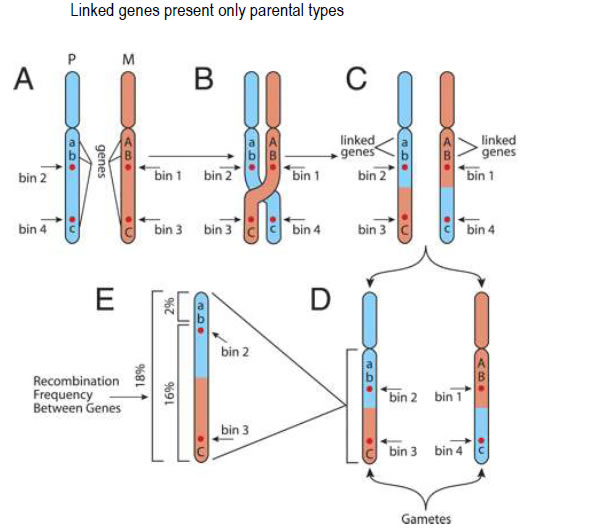
(A) Two homologous chromosomes: blue (paternal) and orange (maternal). Three genes with
separate alleles and linkage " noted (A,a; B,b; C,c;).
(B) Crossing over during meiosis. (chiasma formation)
(C) Two alleles and their linked genes have switched locations via recombination. Four additional
alleles and their associated (A, a; B, b;) have not switched and are considered linked.
(D) Recombined haploid chromosomes segregate separately during meiosis as gametes before
fertilization.
(E) Sample recombination frequencies between genes demonstrating higher rates of
recombination for genes further apart.
| Cross | Result of F2 generation | |
| Phenotypic ratio | Genotypic ratio | |
| Monohybrid Tt × Tt |
3:1 | 1:2:1 |
| Dihybrid cross | 9:3:3:1 | 1:2:1:2:4:2:1:2:1 |
| YyRr × YyRr |
||
| Incomplete dominance Rr × Rr |
1:2:1 | 12:1 |
| Co Dominance and multiple allelisim | ||
| Blood group | Possible genotype | |
| A | IAIA OR IAi |
|
| B | IBIB OR B IBi |
|
| AB | IAIB |
|
| O | ii | |
Crosses of blood group (CO DOMINANCE |
||
| Blood group |
Possible genotype | Possible phenotype |
| A × A | IAIA × IAIA | A |
| IAIA × IAi | A | |
| IAi × IAi | A;O | |
| B × B | IBIB × IBIB | B |
| IBIB × IBi | B | |
| IBi × IBi | B;O | |
| AB × AB | IBIB × IBIB | AB: A;B |
| O × O | ii × ii |
O |
Parent |
Progeny |
|||
| A | B | AB | O | |
| AXA | + | - | - | + |
| AXO | + | - | - | + |
| AXB | + | + | + | + |
| BXB | - | - | - | + |
| BXO | - | - | - | + |
| ABXA | + | + | + | - |
| ABXB | + | + | - | |
| ABXO | + | + | - | |
| ABXAB | + | + | + | - |
| OXO | - | - | - | + |
| KEY | + = POSSIBLE | - = NOT POSSIBLE | ||

Pedigree Analysis
Pedigree is a chart of graphic representation of record of inheritance of a trait through several generations in a family Symbols used:- refer NCERT Text Book
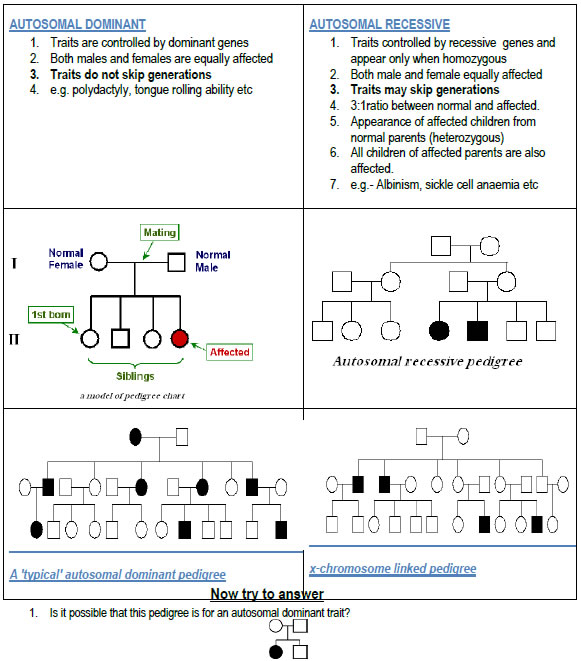
2. Can two individuals that have an autosomal dominant trait have unaffected children?
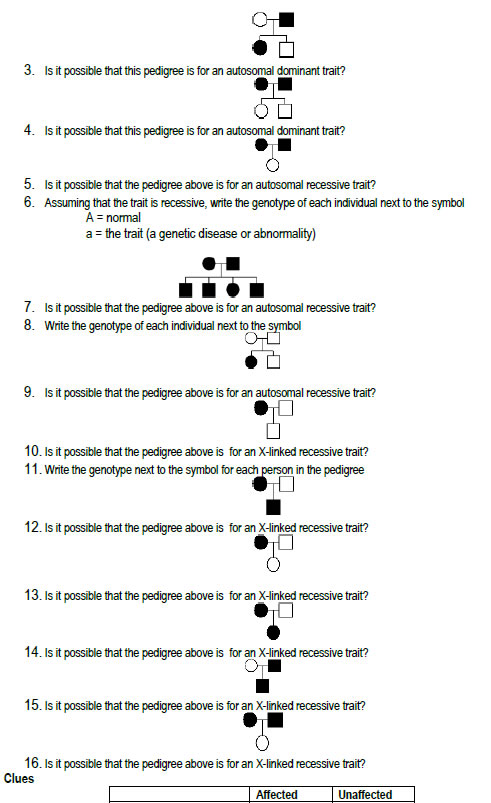
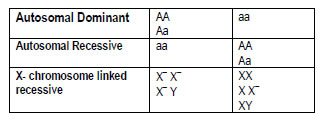
Allele = A factor or letter that makes up a gene. 2 alleles make up one gene. Alternative forms of a
genetic locus; a single allele for each locus is inherited separately from each parent (eg., at a locus for
eye color the allele might result in blue or brown eyes).
Alleles = "B" and "b" are different alleles.
Autosomal = refers to genes that are not found on the sex chromosomes.Autosomal chromosomes are ones that are not XX and XY. A chromosome not involved in sex determination. The diploid human genome consists of 46 chromosomes, 22 pairs of autosomes, and 1 pair of sex chromosomes (the X and Y chromosomes).
Carrier = a person who has a defective gene and a dominant normal gene and therefore, is normal. (Nn)
Centimorgan (cM): A unit of measure of recombination frequency. One centimorgan is equal to a 1% chance that a marker at one genetic locus will be separated from a marker at a second locus due to crossing over in a single generation. In human beings, 1 centimorgan is equivalent, on average, to 1 million base pairs
Chromosomes = 46 are found in human cells. Genes are carried among chromosomes.
Clones: A group of cells derived from a single ancestor.
Cystic Fibrosis = Autosomal recessive. Mucous in lungs.Death in the 20‘s.notices that pure tall plants bred to pure short plants resulted in tall hybrid plants. Tallness was dominant over shortness
Dominant = an allele that overpowers another is dominant.
Down’s Syndrome = due to an extra chromosome in (21st pair).
Gamete = sperm or egg. Germ Cell. In humans, germ cell contains 23 chromosomes
Genetics: The study of the patterns of inheritance of specific traits
Gene = Every trait is controlled by a gene. A human has 20,000 genes. Genes are controlled by 2 factors called "alleles" Each allele comes from a parent.
Genotype = All the genes of a beastie equal the genotype of the beastie. (Genes an organismpossesses)
Genome: All the genetic material in the chromosomes of a particular organism; size generally given as its total number of base pairs.
Germ Cell- An egg or sperm cell.A gamete. In humans, a germ cell contains 23 chromosomes
Haploid= A single set of chromosomes (half the full set of genetic material), present in the egg and sperm cells of animals and in the egg and pollen cells of plants. Human beings have 23 chromosomes in their reproductive cells
Hemophilia = sex-linked recessive. Males get it most often.
Heterozygous= alleles of a gene are "different"
Heterozygosity= presence of different alleles at one or more loci on homologous chromosomes.
Homozygous = alleles of a gene are "the same"
Homologous chromosomes: A pair of chromosomes containing the same linear gene sequences, each derived from one parent
Huntington’s Chorea = Autosomal Dominant. People die at 40 +... Jerky muscular motions
Hybrid = alleles of a gene are "different" (Hh). See heterozygous Independent Assortment: Johann Gregor Mendel‘s 2nd principle. States that alleles of one gene separate independently from alleles of another gene. In other words, eye color does not affect a person‘s ability to roll his or her tongue. In vitro: outside a living organism.
Karyotype : Photomicrograph of an individuals chromosomes arranged in a standard format showing the number, size, and shape of each chromosome type. Linkage: Proximity of two or more genes on a chromosome.The closer together the genes, the lower the probability that they will be separated during meiosis and hence the greater the probability that they will be inherited together. Linkage map: relative positions of genetic loci on a chromosome, determined on the basis of how often the loci are inherited together. Distance is measured in centimorgans (cM). Locus (pl. loci): The position on a chromosome of a gene or other chromosome marker; also, the DNA at that position. The use of locus is sometimes restricted to mean regions of DNA that are expressed.
Meiosis: kind of cell division that produces sperm and egg. Meiosis cuts the number of chromosomes in half. In humans, for instance, the nuclei of body cells contain chromosomes. Due to meiosis, sex cells carry only chromosomes – one chromosome from each original homologous pair.
Mendel, Johann Gregor = The father of genetics (said that traits are controlled by 2 factors etc...)
Mutation = Change in the DNA instructions. Change in DNA sequence. Change can be beneficial, detrimental or neutral. Ultimately results in change in protein. For instance, random genetic mutation gave rise to the dark phenotype of the peppered moth. Non-Disjunction: When homologous chromosomes fail to segregate properly during meiosis. Down syndrome, Turner syndrome and Klinefelter syndrome result from non-disjunction.
Phenotype : the way an organism looks.( EXTERNAL CHARACTERISTICS)
Recessive : A small, weaker allele is recessive. (CANNOT EXPRESS ITSELF IN HETEROZYGOUS CONDITION)
Segregation : One of Mendel‘s principles. Mendel said all genes are comprised of 2 factors, one from each parent. Chromosomes segregate during meiosis. These factors (alleles) of a gene separate during the formation of gametes (sperm and egg). This ensures that each parent contributes 50% of their genetic information.
Sex chromosomes : chromosomes that determine sex (XY and XX) Somatic Cell : Body cell that contains 46 chromosomes in humans.
Tay Sachs : Autosomal recessive. Children die young. Head enlarges.... Trait : feature of an organism.
Copyright @ ncerthelp.com A free educational website for CBSE, ICSE and UP board.